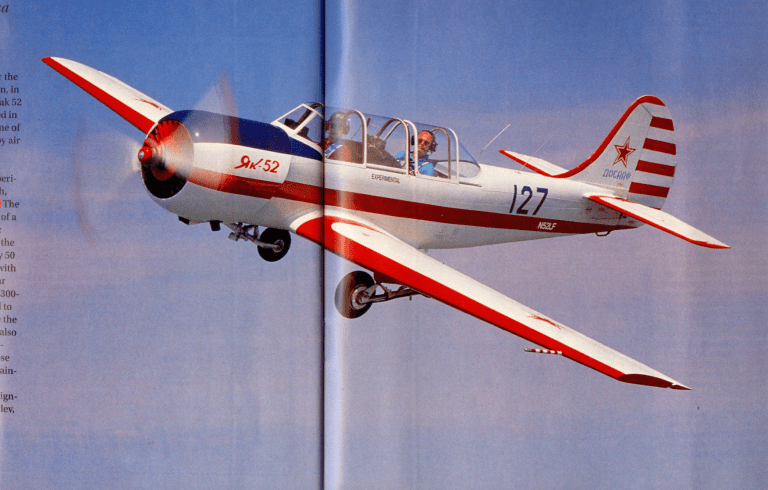
the
{50
vith
Lf
300-
ito
the
also
,se
ainignlev,
l
PHOTOGRAPHY
BY MIKE FIZER
who counts helicopters and supersonic long-range jet fighters among his
successes. Yakovlev allowed members
of the Komsomol youth brigades and
civilian flying clubs to design this tandem-seat version of the Yak 50 in
1978. Manufacturing
was done at
Bacau Aircraft Enterprise in Romania
under a Soviet foreign aid program.
It is a big Russian bear of an airplane, a "get out of my way," heavygauge aluminum brute that is almost
truck-like in sound, ride, and power.
This airplane doesn't get hangar rash;
it gives it. Raw power, a warbird
ambiance, and crisp aerobatic performance are all hallmarks of the Yak 52.
It was meant as an all-purpose aircraft for use by the U.S. equivalent of
college Reserve Officers' Training Corps.
'*
Raw power, a warbird
ambiance, and crisp
aerobatic performance
are all hallmarks
of the Yak 52.
cadets-Soviet
youth of the DOSAAF
(All Union Voluntary Society for Assistance to the Army, Air Force, and Navy).
It was also used by civil sport aviation
clubs such as those in Lithuania, where
the Yak 52s mentioned in this article
were purchased. Many of the Yak 52's
systems are similar to those in Russian
military aircraft, such as the avionics,
fuel system, and air brakes. The commonality provided a pool of trainees
that could transition quickly to military
aircraft in the event of a national emergency, as incongruous as stepping out of
a radial-engine aircraft with fabric control surfaces into a jet might seem.
It rides on air in more ways than
one, lowering its flaps and gear, operating the brakes, and even starting the
engine with compressed
air from
tanks behind the rear seat. Reliance on
air, rather than electrically powered
starters and other systems, helps the
Yak 52 survive Russian winters as
tough as the Yak itself.
As with MiG brakes (see "Cold Warbirds," July Pilot), the Yak has a handle
much like that used for bicycle brakes,
mounted vertically on the control
stick. Squeeze when the rudder is in a
neutral position, and both wheels
92 • SEPTEMBER
1994
Cockpit detail includes a finely made clock
(above) and a brake handle mounted on the
control stick (below). The mounting
bracket for a GPS receiver (upper right
comer) was added by the American owner.
receive equal braking. Need a left
turn? Estimate the amount of braking
needed, convert that to a measure of
forward travel of the rudder pedal, and
squeeze the hand trigger again. Put
your left foot in, then your right foot,
and pretty soon you're doing the Yak
hokey-pokey down the taxiway.
Each time the trigger is squeezed, a
satisfying burst of air surges from the
tanks, like a tractor-trailer
pulling
into a truck stop. Obviously, an air
tank pressurized to 50 atmospheres
might one day leak, preventing the
gear from being extended. But the
Romanians thought of that and provided an auxiliary air tank just in
case. After takeoff,
it takes the
engine-driven air pump 10 to 20 minutes to replace the pressure lost during gear retraction.
'*
Put your left foot in,
then your right foot, and
pretty soon you're doing
the Yak hokey- pokey
down the taxiway.
The aircraft is either a student's
nightmare or an instructor's dream,
depending on whether you're in the
front student cockpit or the rear
instructor station. The rear control
stick has a button on top that most
pilots would mistake for a push-totalk switch. However, Soviet instructors used it to fail the brakes as a training exercise (or to override a student's
overeager efforts at braking). Other
switches allow the instructor to fail the
non-tumbling attitude indicator and
other instruments
for partial-panel
training, thus making it a good allaround trainer. Student overconfidence can be cured by simply nipping
all the switches, holding the brake failure button, and sitting back to watch
the fun.
Two Yaks were flown in researching
this article: The one photographed is
owned by Rob Montague, based in
Winchester, Virginia, and was once
owned by the Kaunas Flying Club in
Lithuania.
The other is owned by
Lewis M. Cathro and is based at
Potomac (Maryland) Airfield, near
Andrews AFB. Montague and Cathro
bought their Yaks through Stephen J.
AOPA PILOT'
93
Beaver, of Winchester, Virginia, who
has aided in the sale of 17 Yak 52s in
America and offers these tips for buyers: Starting with the 1984 model, the
Yak 52 was manufactured
with a
beefed-up main-spar carry-through.
Older aircraft had a kit installed to
strengthen
the main-spar
carrythrough, but it spoils the aircraft's
appearance.
You should be able to
find a used Yak 52 from 1987 on up
with only 200 hours on it for about
$55,000. That includes an overhauled
engine, flight manuals, and a pilot
check-out.
The aircraft was designed to be
maintained by untrained hands. The
Soviet approach to maintenance was
to beat the life out of them for five
years, then fix everything that is broken in one super inspection.
Most pilots find it is a big step up to
*
Getting into the
aircraft provides a
side benefit of
ownership: an aerobic
stretching exercise.
7he huge wooden propeller requires tall landing gear to provide ground clearance. There are
attachments under the left wing root for a stepladder, although it is not included with used aircraft·
a Yak 52, not only because mastery of
the aircraft requires lots of practice,
but also because used Yak 52s don't
come with steps that were designed to
latch onto the rear of the left wing.
Getting into the aircraft provides a
side benefit of ownership: an aerobic
stretching exercise. The wing is nearly
3 feet off the ground.
Cathro has left some of the original
Russian Cyrillic writing on gauges and
controls in the rear cockpit, although
the Federal Aviation Administration
required English-language
labels in
the front cockpit. To make the aircraft
legal in the United States, Cathro had
to add an encoding transponder,
an
altimeter graduated in feet, an airspeed indicator in knots, an emergency locator transmitter,
and-for
aerobatics-American
parachutes.
Cockpit
highlights
include
a
detailed and finely made clock (which,
like the engine, winds to the left), a
military-style throttle, an annunciator
panel in front and back cockpits
resembling a Christmas tree when
fully lit (Montague has labeled one of
the lights "Panic Button"), and a chan94 • SEPTEMBER
1994
Manually operated vanes behind the propeller control cooling air to the nine-cylinder Vendeneyev
M14P engine. The rear instmctor's station contains switches for failing systems in flight.
nel-tuned automatic direction finder.
The primer is a two-position switch:
One position-used
in the event of
engine failure-sends
fuel to the cylinders, while the other sends fuel to the
primer intake for engine start. If the
fuel pump fails in flight. the pilot must
select the primer's manifold position
and continuously pump the primer to
pressurize the manifold.
Flying the Yak 52 is an adventure,
starting with preflight.
Arrival at
Potomac Airfield finds Cathro pouring
oil into the engine from a 5-gallon can.
A joke told in Lithuania suggests oil
tankers arrive simultaneously with fuel
trucks to service Russian aircraft, with
both trucks pumping equal quantities.
The Yak holds 4.25 gallons (lGliters) of
oil and can operate with a minimum
level of 1.12 gallons (8 liters).
Nothing about the aircraft is conventional by American standards, from
its left-turning 3GO-hp supercharged
engine (although it is not fuel injected,
it uses a pressurized carburetor) to its
automatic altitude compensation mixture control. The automatic mixture
control is biased toward extremely cold
temperatures and has been a nuisance
in warmer U.S. climates. Because the
engine is left-turning, left rudder, not
right, is needed for climb-out. Takeoff
with a right crosswind has proven difficult for some owners because torque
and p-factor are already pulling the aircraft to the right. The nearly 8-footlong wooden propeller has tips as big
as canoe paddles.
Engine start is a complicated handdance that begins as pressurized air is
released into the engine with a loud
pop-timed
to operate each of the
cylinders in turn. The pilot must hold
down a button with the left hand to
release the air and trigger a shower of
sparks into the cylinders. Once it is
confirmed the prop is actually turning
left, the pilot flips the magneto switch
with the third finger of the left hand to
a position marked "1+2," meaning
"both." The right hand is standing by
the primer in case additional fuel is
needed in the cylinders.
Once the
engine starts. the left hand goes to the
throttle quadrant to adjust rpm to 40
percent. (Expressing power in percentages prepares the pilot for jet
transition later.)
Rapid takeoff acceleration
leaves
little doubt of the aircraft's power.
Shortly after rotation at 75 to 80 knots,
the vertical speed indicator settles on
AOPA PilOT • 95
1,300 feet per minute (some operators
claim 2,000 to 3,000 fpm). The nose is
pitched up 15 to 25 degrees to maintain 80 to 85 knots. Power is set at 80
percent rpm and 80 millimeters
of
mercury (the equivalent of about 30
inches of manifold pressure).
Cruise power is left at 80 percent
rpm for most aerobatics, and manifold
pressure is adjusted as needed. Crosscountry flights are made at 70 percent
rpm and 70 of mm manifold pressure.
For best endurance,
use 60 percent
rpm and 60 to 65 of mm.
Engine cooling is controlled
by
manually operated Venetian-blindlike cooling vanes in the front of the
*
Nothing about
the aircraft is
conventional by
American
standards.
engine cowling.
The main landing gear retract forward and attach themselves to hooks
near the leading edge, with wheels
protruding
several inches into the
slipstream, a la Douglas DC-3. As with
the DC-3, the Yak can land with its
gear up and still roll to a safe stop with
brakes fully operational. One did that
in the old Soviet Union; the wooden
prop was smashed, of course, but was
replaced and the aircraft made operational in an hour or so, without anyone bothering to inspect the engine.
The first turn out of the Potomac
pattern is a crisp roll to a 30-degree
bank that stops smartly. Even slight
aileron pressure is enough to take
advantage of the Yak's impressive roll
rate, which can reach 150 degrees per
second with full control deflection. The
airplane begs to be played with; by the
end of the flight, I was making all
turns-even
small heading changesby snapping into a 60-degree bank,
then snapping the wings level again.
Too bad the fun has to end so soon,
with only a gO-minute fuel supply
(more than two hours at lower cruise
power settings). Another restriction is
the FAAExperimental/exhibition
category of certification. which limits all
flights to within 100 nautical miles of
home base (soon to be 300 nm if a pro-
posed regulatory change is approved).
The aircraft can, of course, be used for
proficiency and flown farther than 100
Yakovlev 52
Base price: $50,000 to $120,000
Specifications
Vendeneyev M 14P.
air-cooled, 360-hp, nine cylinder
Recommended TBO Not specified. Some
owners suggest 900 to 1,500 hr
(using American oil, some
dealers promise 2,250 hr)
Propeller
Vendeneyev V530 0-35,
constant-speed. twoblade wood, 96-in diameter
25 ft 6 in
Length
9 ft 8 in
Height
30 ft 8 in
Wingspan
Wing area
161.5sqft
Wing loading
18.08Ib/sq ft
Power loading
7.881b/hp
Seats
two, tandem
Cabin length (per cockpit,
36in
front and back are the same)
Cabin width
30in
44in
Cabin height
2,205 Ib
Empty weight
2,838 Ib
Gross weight
Useful load
5781b
+7/-5
Max G loading
Fuel capacity, std
32.2 gal (30 gal usable)
Oil capacity
4.25 gal, 2.64 gal for
aerobatic flight
Powerplant
Performance
Takeoff distance, ground roll
594 ft
Max demonstrated crosswind
component
II kt
2400/ sec
Roll rate
Cruise speed/endurance w/45-min rsv
@ 70% power
130 kt/l.5 hr
(fuel consumption. 14 to 18 gph)
Service ceiling
13.000 ft
Landing distance, ground roll
975 ft
Inverted flight duration
two min
Limiting and Recommended Airspeeds
Vx (best angle of climb)
80 KIAS
Vy (best rate of climb)
91 KIAS
VFE (max flap extended)
93 KIAS
VLE (max gear extended)
110 KIAS
VNE (never exceed)
227 KIAS
VR (rotation)
75 KIAS
VS1 (stall, clean)
60 KIASupright,
76 KJASinverted
Vso (stall, in landing configuration) 55 KIAS
For more information.
contact Marcus
Bates in Odessa, Texas. at 9151563-2285, or
1nternational Jets in Gadsden. Alabama, at
2051442-8099. For information on used Yak
52s, call Stephen J. Beaver at 7031667-2130.•
All specifications are based on manufac- '
tzIrer's calClilations. All performance figures
are based on standard
day, standard
atmosphere. sea level, gross weight conditions unless otherwise noted.
nm to places of
exhibition. In aerobatic flight, it burns
33 gallons per hour,
but 70 percent
brings fuel consumption back to 18
gph. The aircraft is
stressed for plus
7/minus 5 Gs, tough
for its time but no
match for aircraft
used by today's top
competitors.
The flight demonstration begins with
a stall series. The Yak
52 gives plenty of
warning via tail buffet that it is about to
let go. Further backpressure induces a
full stall accompanied by the left wing
dropping (common
in many high-performance aircraft).
offering a hint that
the normally polite
Yak 52 can lose its
temper as quickly as
a trained circus tiger.
Wingovers
are
followed by loops
and aileron rolls.
Loops are entered
at 162 knots, 82percent rpm, from
level flight
and
aileron rolls can be
entered
at any
speed above stall.
There is energy to
spare as we go over the top, without so
much as a hint of a stall. Then it's time
to return to Potomac Airfield for a low
pass and a landing or two.
Landing the Yak 52 can be tricky for
pilots transitioning
from low-slung
American
single-engine
aircraft,
because the Yak pilot's eyes are nearly
7 feet above the runway. On downwind, 70 percent rpm and 40 mm of
manifold pressure will keep the aircraft
flying level at 90 knots. Lower the gear
abeam the point of intended touchdown, and push the prop control to
maximum rpm to descend at 85 knots.
Once the runway is made, lower the
flaps (they have just one position-45
degrees) and slow to 80 knots.
The flaps produce a huge air-braking
effect that requires the nose to be low-
ered toward the threshold. Look at the
red and white barber-pole indicatorswires sticking up through the wing-to
confirm that the gear is down. At the
threshold, reduce the throttle to idle,
and raise the nose as if landing a taildragger in a three-point attitude. The
aircraft touches down at 50 knots.
Once Cathro demonstrated a greaser landing, it was back into the air for
another Potomac River cruise.
Flying through an evening sunset
along the Potomac River south of
Washington, we pass over a military
laboratory used to test aircraft electronic systems. Parked about the
grounds of the research center are
America's front-line fighters: F-14s,
A-6s, and F-15s. And up here, the red
star-a unique juxta position.
D



